How Governments Will Default on their Sovereign Debt
Economics / Global Debt Crisis Sep 21, 2010 - 04:42 AM GMTBy: John_Mauldin
 As I am traveling in Europe for a few more days, it seems appropriate to review the very fascinating work of Arnuad Mares of Morgan Stanley in London. He poses the very provocative question: "Ask Not Whether Governments Will Default, but How?" and comes up with some very interesting statistics. He suggests that simply looking at debt to GDP misses the point and offers four other ways we should also evaluate sovereign debt risk. This is a very worthy contribution to Outside the Box.
As I am traveling in Europe for a few more days, it seems appropriate to review the very fascinating work of Arnuad Mares of Morgan Stanley in London. He poses the very provocative question: "Ask Not Whether Governments Will Default, but How?" and comes up with some very interesting statistics. He suggests that simply looking at debt to GDP misses the point and offers four other ways we should also evaluate sovereign debt risk. This is a very worthy contribution to Outside the Box.
The question I get over and over as I travel and present my thoughts is "When is the US going to get real about its fiscal deficits?" There is little sympathy for the massive deficits we are running. We are making Europe, or at least the part of Europe I am visiting, very nervous. Let us hope after the next elections we can say we are getting a handle on the deficits, and from both sides of the aisle and not just the Republicans. This is going to require cooperation.
Mallorca is very beautiful, but they have a very small and particularly nasty breed of wasp that has my left hand and fingers quite swollen and sore. But that did not take away from sitting on the balcony with my partners late one night watching a spectacular lightening display as a thunder storm was coming our direction. Then all of a sudden, we saw something that none of us have ever seen.
The moonlight was behind us, and shining through the clouds formed a very clear white rainbow. It was an amazing sight. I will never forget it. Not sure what it is a metaphor for, but I was glad to have witnessed it.
Your sometimes you just get lucky analyst,
John Mauldin, Editor Outside the Box
Sovereign Subjects Ask Not Whether Governments Will Default, but How
By Arnuad Mares
This is the first issue of Sovereign Subjects, a new Morgan Stanley publication focusing on sovereign risk in advanced economies. In this first installment, we take a broad perspective on government balance sheets and raise several themes to which we will return in more depth in subsequent issues. We encourage clients to provide us with feedback on this new publication.
Debt/GDP ratios are too backward-looking and considerably underestimate the fiscal challenge faced by dvanced economies' governments. On the basis of current policies, most governments are deep in negative equity.
This means governments will impose a loss on some of their stakeholders, in our view. The question is not whether they will renege on their promises, but rather upon which of their promises they will renege, and what form this default will take.
So far during the Great Recession, sovereign (and bank) senior unsecured bond holders have been the only constituency fully protected from partaking in this loss.
It is overly optimistic to assume that this can continue forever. The conflict that opposes bond holders to other government stakeholders is more intense than ever, and their interests are no longer sufficiently well aligned with those of influential political constituencies.
There exists an alternative to outright default. 'Financial oppression' (imposing on creditors real rates of return that are either negative or artificially low) has been used repeatedly in history in similar circumstances.
Investors should be prepared to face financial oppression, a credible threat against which current yields provide little protection.
Ask Not Whether Governments Will Default, but How
The sovereign debt crisis is not European: it is global. And it is not over. The European sovereign debt crisis of spring 2010 was a misnomer in more ways than one: there was not one crisis but two. And it will continue well beyond 2010, in our view. The first crisis was, and remains, an institutional crisis of the euro, caused by a flawed multilateral fiscal surveillance framework. Steps have been taken towards a correction of the flaws with a move from peer pressure to peer control of fiscal policy. This is reflected by the acceptance by the Greek, Spanish and Portuguese governments of fiscal measures largely dictated from Berlin and Brussels. The second crisis was, and remains, a sovereign debt crisis: a crisis caused by sovereign balance sheets being overstretched, to the point where insolvency ceases to be merely possible and becomes plausible. This crisis is not limited to the periphery of Europe. It is a global crisis and it is far from over. We take a high-level perspective on the state of government balance sheets and conclude that debt holders have to be prepared to enter an age of 'financial oppression'.
Debt/GDP has been higher before, so why worry? As government debt and deficits have swollen to levels for which there exist few recent references, all eyes have turned to a more distant past in the hope of finding some guidance as to what future awaits bondholders. At first glance, history appears to be reassuring, though that is deceptive, in our view. Several advanced countries have experienced debt/GDP levels well in excess of current ones. The US emerged from Word War II with a public debt/GDP ratio of approximately 110%, and the UK with a ratio of 250%. The UK national debt has averaged almost 100% of GDP since its creation in 1693 (see Exhibit 1). Yet the UK government never defaulted through that period. France's public debt stood at about 280% of GDP at the end of World War II. It did not default either. As a matter of fact France defaulted only once - in 1797 - since the creation of its own national debt in 1789. This is remarkable, considering the number of political, military and economic crises the country went through. So why worry now?
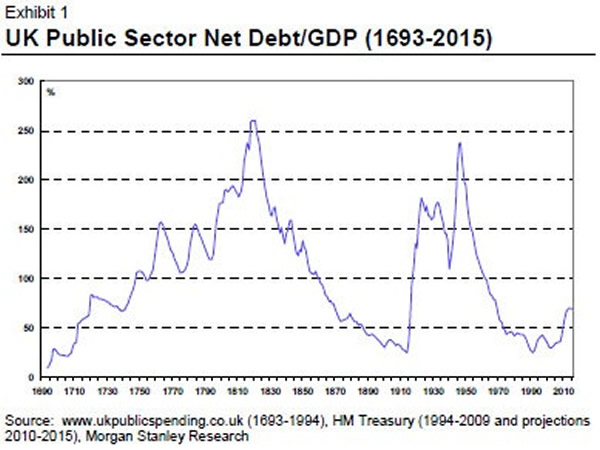
Four reasons why debt/GDP misses the point. The problem with these historical comparisons is not the reference: how governments dealt with their war debt burdens sheds useful light on what might be in store for coming years. Rather, the problem lies with the measurement tool: debt/GDP is the most widely used debt metric, but we believe that it is a very inadequate indicator of government solvency. There are four reasons for this:
- Gross versus net debt: First, debt/GDP is a measure of gross indebtedness. It therefore overstates the size of the government's net financial liabilities, especially when - as has been the case through the crisis - debt is being raised for the purpose of on-lending or acquiring assets. Where measures of net debt exist, they provide an apparently less alarming picture of the government's balance sheet. The difference can be sizeable (in excess of 17% of GDP in the UK currently, for instance). Good news, however, stops here.
- Missing liabilities: The second flaw of debt/GDP is that it only accounts for part of a government's contractual liabilities. There exists a broad range of liabilities that are debt, yet are not captured in national accounts. To take one example, in March 2008 the UK Government Actuary Department valued the government's unfunded civil service pension liabilities - that is, the contractual claims on government accumulated to date by civil servants - at £770 billion. That is 58% of GDP, not captured by the debt/GDP ratio. Debt/GDP does not capture contingent liabilities either.
- It is not GDP but government revenues that matter: Whatever the size of a government's liabilities, what matters ultimately is how they compare to the resources available to service them. One benefit of sovereignty is that governments can unilaterally increase their income by raising taxes, but they will only ever be able to acquire in this way a fraction of GDP. Debt/GDP therefore provides a flattering image of government finances. A better approach is to scale debt against actual government revenues (see Exhibit 2). An even better approach would be to scale debt against the maximum level of revenues that governments can realistically obtain from using their tax-raising power to the full. This is, inter alia, a function of the people's tolerance for taxation and government interference. Seen from this angle, the US federal debt no longer compares quite so favourably with that of European governments.
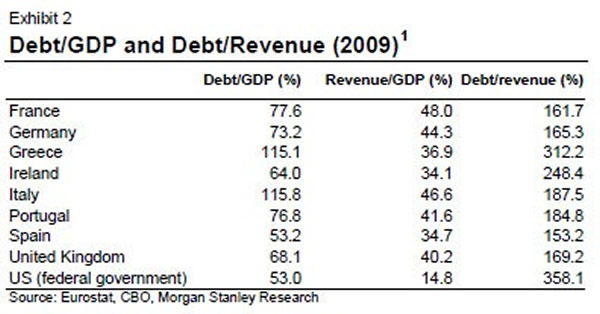
- Debt/GDP looks at the past. The main problem is in the future: The fourth and largest flaw of debt/GDP is that it is an entirely backward-looking indicator. It only accounts for the accumulation of past deficits. This captured reasonably well the magnitude of the fiscal challenge at the end of World War II because at that time the challenge did indeed result entirely from the past: large wartime deficits had pushed debt ratios higher, but governments were no longer running deficits, nor were there expectations of them doing so in subsequent years.
- By contrast, the accumulation of past deficits now represents only part of the problem for advanced economies' governments. The other part consists of coping with the large structural deficits opened up by the crisis and compounded by the fiscal consequences of ageing. What raises questions about debt sustainability is not so much current debt levels as the additional debt that will accumulate in coming years if policies do not radically change. Debt ratios do not capture this part of the problem.
Looking beyond debt: valuing government equity. A comprehensive look at government balance sheets provides a much gloomier reading of their solvency. Exhibit 3 shows a stylised representation of the government balance sheet. In addition to financial assets and liabilities appear 'fiscal' assets and liabilities. On the asset side is the power to tax, which is the main asset and resource of any government. It can be conceived as a variable rate claim on GDP, where the rate depends on the level of taxation. Its value on the balance sheet is therefore the net present value of all future tax revenues. On the liability side appears a 'social' liability, which represents the promise of the government to its electorate to spend resources on defence, justice, education, health and any other existing government policy. Its value is the net present value of all future primary expenditure. The difference between the power to tax and the social liability is the net present value of all future structural primary deficits (by definition, the cyclical component of the deficit should sum up to zero over time).
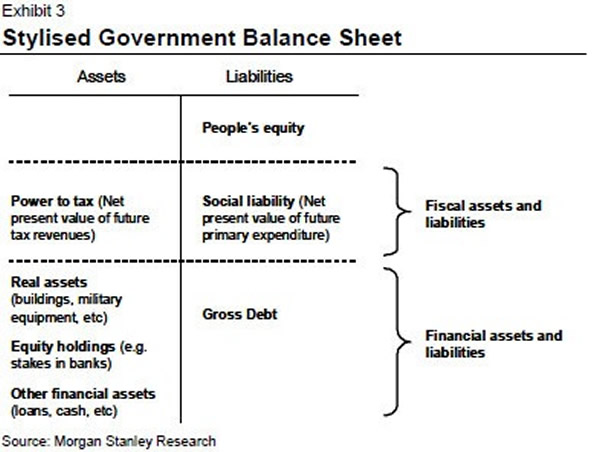
The residual is represented on the balance sheet as the people's equity, by analogy to a corporate balance sheet. This is effectively the net worth of the government in the broadest sense, and a measure of its solvency. It can be interpreted very simply as follows: if positive, the government can release value to taxpayers by lowering taxes without reneging on its promises to other stakeholders (bond holders and beneficiaries of public services). If negative, the government is insolvent. In other words, some or all of its stakeholders must suffer a loss: either taxpayers (through a higher tax burden), or beneficiaries of public services (through lower expenditure) or bond holders (through some form of default).
Adding the cost of ageing to that of the crisis. An estimate of government 'equity' value can be obtained by adding the net present value of all future primary deficits to existing financial debt. Future primary deficits result from two influences:
- Current structural deficits, opened up or aggravated during the crisis by the permanent loss of tax revenues that accompanies a permanent loss of output. This is the part of the deficit that will remain - once temporary stimulus measures are withdrawn and growth has returned to trend - under an assumption of unchanged policies;
- The additional structural deficit that - under the same assumption of unchanged policy - would gradually result from ageing, mostly through a rise in health and pension expenditure.
The fiscal challenge is unprecedented. Exhibit 4 provides illustrative estimates of government net worth under this approach. What matters here is not the exact numbers, which are very dependent on underlying assumptions (see box). What matters is the sign of net worth (negative everywhere), its broad order of magnitude (a large multiple of current or historical debt levels almost everywhere) and the ranking of governments.
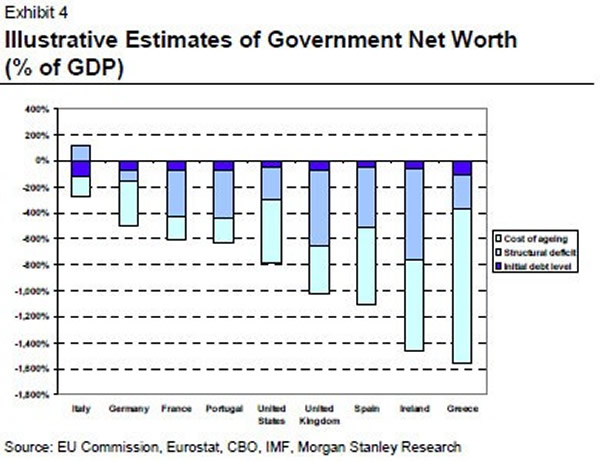
This depressing perspective on global public finances is not exactly news. The same calculations based on pre-crisis data were not nearly as bad, but not significantly more encouraging either, with most governments already then in negative equity. The crisis has had three noticeable effects nonetheless:
Estimating Government Net Worth: Underlying Assumptions
Our illustrative estimates of government net worth are based on the following assumptions:
Initial debt level: For the purpose of simplicity, consistency and availability of data across countries, we use the projected debt level of gross debt/GDP at end-2010 - even though the correct aggregate to use here is clearly net financial debt. This has no material bearing on the conclusions of the exercise.
Structural deficit: The exact size of the structural deficit is a guesstimate at best - it requires an assessment of potential GDP, a notoriously imprecise concept. Calculations are based on official projections of cyclically adjusted primary deficits in 2011, and we assume that this deficit is unchanged in every subsequent year (as a percentage of GDP). This is consistent with the assumption of 'unchanged policy'. In practice governments do intend to change policy - and thereby to reduce the size of the structural deficit. In doing so they inflict a loss on taxpayers (if raising taxes) and on other stakeholders (when cutting expenditure). As the purpose of the exercise is precisely to evidence the magnitude of the loss that these will suffer, assuming an unchanged structural deficit at current levels is the appropriate reference point. It is for this same reason that we use as a reference point 2011 and not 2010 data: the latter is still distorted in some countries by stimulus measures, which, being temporary by nature, never constituted a 'promise to spend'. The removal of the stimulus measure does not therefore inflict on stakeholders a loss as we define it.
Cost of ageing: Estimates of the cost of ageing on public finances - even under unchanged policy - rely heavily on demographic and economic projections. For the purpose of our illustrative calculations, we used long-term projections of age-related expenditure published by the EU and - for the US - by the IMF. For the same reason as above, the reference point is pre-fiscal retrenchment, i.e., the calculation does not take account of the ongoing pension or healthcare reforms decided or being discussed this year in many countries.
Discount rate: The net present value of future fiscal deficits is naturally heavily dependent on the discount rate used. The calculations illustrated in Exhibit 4 assume a discount rate 100bp above the nominal GDP growth rate across all countries.
- It has aggravated the problem everywhere, mostly through a permanent shock to tax revenues and through a transfer of liabilities and risk from the private to the public sector, without a commensurate transfer of resources.
- In doing so, it has intensified the inherent conflict that exists between bond holders and other government stakeholders that all compete for resources that are finite and, crucially, insufficient to satisfy all their claims - to the point where holders of government debt have started contemplating default as a plausible outcome rather than a mere theoretical possibility...
- ... which, in turn, considerably shortened the time available to governments to resolve this conflict one way or the other, with a loss of market access a credible penalty for procrastination.
It is not whether to default, but how, and vis-à-vis whom. What this means is that - as indicated above - governments will impose a loss on some of their stakeholders and have in fact started to do so (across Europe at least). The question is not whether they will renege on their promises, but rather upon which of their promises they will renege, and what form this default will take. From the perspective of sovereign debt holders, this translates in two questions:
- Does their claim on governments rank senior enough relative to other claims to fully shelter them from losses?
- If it does not, what form will this loss take?
Bonds remain the most senior government liability. There are good reasons why government bonds should rank senior to most other liabilities. To mention one: governments need to be able to raise finance to fund public investment as well as to perform their macroeconomic stabilisation role. They cannot issue equity, and cannot credibly issue secured debt. Unrestricted access to unsecured, confidence-based funding is core to their 'business model', as it is for banks. This was, historically at least, the main argument for honouring sovereign debt. There are others, not least the consequences of a government default for output and for financial stability when banks own substantial exposure to the sovereign.
Bond holders have been fully sheltered from loss through the Great Recession - so far. This seems consistent with historical experience, both from yesteryear (see Exhibit 1) and yesterday. So far indeed, holders of sovereign debt have been exempt from sharing in the loss of income and wealth that has affected everybody else: shareholders have absorbed direct losses. Homeowners have faced (uneven) losses of property value. Taxpayers have experienced a reduction in their lifetime income through current and prospective increases in taxation. Government employees and other stakeholders are suffering even larger losses through current or prospective reduction in government expenditure. Only holders of senior unsecured debt issued by the largest governments and - in most cases - banks have been sheltered so far.
Can this realistically continue forever? This is ultimately a question of political economy. It is worth noting that, in the case of Greece, public acceptance of austerity measures - cuts in civil service compensation in particular - has become conditional on the perception that the cost of fiscal retrenchment would be distributed fairly across constituencies (hence the very public crackdown on wealthy tax evaders). Whether and when bond holders are asked to share in the common pain - not just in Greece - depends on:
- The intensity of the conflict that opposes them to other stakeholders. As discussed earlier, this is likely stronger than it has ever been; and
- The extent to which the interests of bond holders are aligned with those of the most politically influential constituencies.
Financial oppression as an alternative to outright default. Outright default is not the only way to impose losses on creditors. Financial oppression - the fact of imposing on creditors real rates of return that are negative or artificially low - can take other forms: repaying debt in devalued money (e.g., through unanticipated inflation), taxation or regulatory incentives on institutions to purchase government debt at uneconomic prices, for instance (see also "Default or Inflate or...", The Global Monetary Analyst, February 24, 2010). Repaying debt in devalued money is particularly effective when the initial stock of debt is high - as it is now. Distorting prices in the government's favour is particularly effective when the financing requirement is high - also a situation we face now and for years to come.
History is not so reassuring after all. Financial oppression has taken place in the past as an alternative to default in countries that are generally considered to have a spotless sovereign credit record. Examples include: the revocation of gold clauses in bond contracts by the Roosevelt administration in 1934; the experience by then Chancellor of the Exchequer Hugh Dalton of issuing perpetual debt at an artificially low yield of 2.5% in the UK in 1946-47; and post-war inflationary episodes, notably in France (post both world wars), in the UK and in the US (post World War II). Each took place at a time when conflicting demands on finite government resources were high, and rentiers wielded reduced political power.
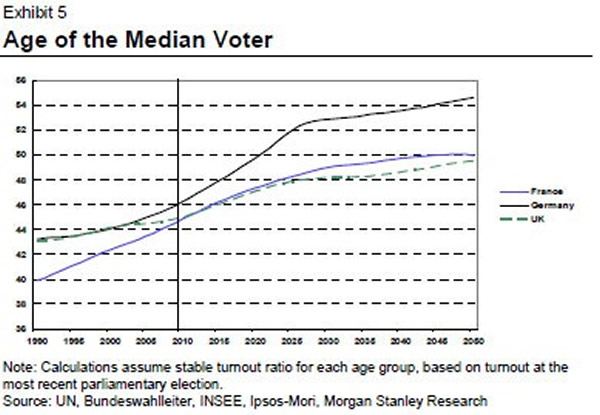
The interests of bond holders are no longer perfectly aligned with those of the most powerful constituency. Exhibit 5 shows the rapid increase in the age of the median voter in large western European countries. In principle, having governments and policies shaped by older voters ought to be favourable to bond holders, because bonds are more likely to be held by the old than the young and policies that would harm bond holders would often also harm the old (inflation for instance redistributes wealth from the old to the young). The first problem with this argument is that the constituency of the elderly is also the biggest competitor to bond holders because of the considerable size of the direct claim it has on the government balance sheet in the form of pensions, social security and health insurance, etc. The more reluctant they are to relinquish these claims, the higher the risk for bond holders. The second problem is the dilution of bond ownership, which results in lesser alignment of the interest of bond holders with older voters: even in the UK, where the domestic and pension industry has traditionally dominated the gilt market, its ownership of gilts has decreased in recent years from around 60% to 40% of the market excluding Bank of England purchases), to the benefit of foreign investors.
No insurance against financial oppression at current yield levels. Against this background, it seems dangerously optimistic to expect that sovereign debt holders can be continuously and fully sheltered from partaking in the loss of wealth and income that has affected every other group. Outright sovereign default in large advanced economies remains an extremely unlikely outcome, in our view. But current yields and break-even inflation rates provide very little protection against the credible threat of financial oppression in any form it might take. Note that a double-dip recession would not invalidate this conclusion: it would cause yet further damage to the governments' power to tax, pushing them further in negative equity and therefore increasing the risks that debt holders suffer a larger loss eventually.
John F. Mauldin
johnmauldin@investorsinsight.com
John Mauldin, Best-Selling author and recognized financial expert, is also editor of the free Thoughts From the Frontline that goes to over 1 million readers each week. For more information on John or his FREE weekly economic letter go to: http://www.frontlinethoughts.com/learnmore
To subscribe to John Mauldin's E-Letter please click here:http://www.frontlinethoughts.com/subscribe.asp
Copyright 2010 John Mauldin. All Rights Reserved
Note: John Mauldin is the President of Millennium Wave Advisors, LLC (MWA), which is an investment advisory firm registered with multiple states. John Mauldin is a registered representative of Millennium Wave Securities, LLC, (MWS), an FINRA registered broker-dealer. MWS is also a Commodity Pool Operator (CPO) and a Commodity Trading Advisor (CTA) registered with the CFTC, as well as an Introducing Broker (IB). Millennium Wave Investments is a dba of MWA LLC and MWS LLC. Millennium Wave Investments cooperates in the consulting on and marketing of private investment offerings with other independent firms such as Altegris Investments; Absolute Return Partners, LLP; Plexus Asset Management; Fynn Capital; and Nicola Wealth Management. Funds recommended by Mauldin may pay a portion of their fees to these independent firms, who will share 1/3 of those fees with MWS and thus with Mauldin. Any views expressed herein are provided for information purposes only and should not be construed in any way as an offer, an endorsement, or inducement to invest with any CTA, fund, or program mentioned here or elsewhere. Before seeking any advisor's services or making an investment in a fund, investors must read and examine thoroughly the respective disclosure document or offering memorandum. Since these firms and Mauldin receive fees from the funds they recommend/market, they only recommend/market products with which they have been able to negotiate fee arrangements.
Opinions expressed in these reports may change without prior notice. John Mauldin and/or the staffs at Millennium Wave Advisors, LLC and InvestorsInsight Publishing, Inc. ("InvestorsInsight") may or may not have investments in any funds cited above.
Disclaimer PAST RESULTS ARE NOT INDICATIVE OF FUTURE RESULTS. THERE IS RISK OF LOSS AS WELL AS THE OPPORTUNITY FOR GAIN WHEN INVESTING IN MANAGED FUNDS. WHEN CONSIDERING ALTERNATIVE INVESTMENTS, INCLUDING HEDGE FUNDS, YOU SHOULD CONSIDER VARIOUS RISKS INCLUDING THE FACT THAT SOME PRODUCTS: OFTEN ENGAGE IN LEVERAGING AND OTHER SPECULATIVE INVESTMENT PRACTICES THAT MAY INCREASE THE RISK OF INVESTMENT LOSS, CAN BE ILLIQUID, ARE NOT REQUIRED TO PROVIDE PERIODIC PRICING OR VALUATION INFORMATION TO INVESTORS, MAY INVOLVE COMPLEX TAX STRUCTURES AND DELAYS IN DISTRIBUTING IMPORTANT TAX INFORMATION, ARE NOT SUBJECT TO THE SAME REGULATORY REQUIREMENTS AS MUTUAL FUNDS, OFTEN CHARGE HIGH FEES, AND IN MANY CASES THE UNDERLYING INVESTMENTS ARE NOT TRANSPARENT AND ARE KNOWN ONLY TO THE INVESTMENT MANAGER.
John Mauldin Archive |
© 2005-2022 http://www.MarketOracle.co.uk - The Market Oracle is a FREE Daily Financial Markets Analysis & Forecasting online publication.



